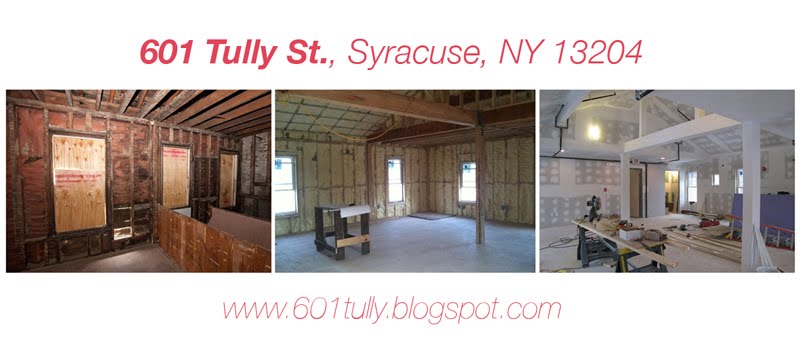About 601 Tully
Check out our new website! 601Tully.syr.edu
601 Tully is a center for engaged practice in Syracuse, NY developed by artist and professor Marion Wilson with a rotating collaborative team of 54 students and neighbors and Anda French of French 2Design. It's a site for meaningful exchange between artists, community members, and scholars in the co-production of culture.
601 Tully includes a contemporary art space, a public events space, a bookstore, a teaching garden, and Recess Cafe West.
In 2009, Wilson purchased the condemned two-story home and local drug hub, and throughout five semesters, Wilson's design/build class re-zoned, designed, renovated and now sustains the physical and programmatic aspects of 601 Tully. The collaborative team has consisted of artists, architects, environmentalists, Fowler High School students, Green Train Workforce, neighbors, and the occasional passerby.
601 Tully is made possible by the generous support of the Syracuse University School of Education, The Kauffman Foundation, The Near West Side Initiative, Imagining America, Home HeadQuarters Inc., Say Yes to Education, and National Grid.
Find us on Facebook!
Thursday, June 9, 2011
Planting ideas is Hypertufa pots and troughs
Native sedums are also excellent choices. Sedum ternatum, with its dark green foliage and bright white flowers, will fill a container and droop nicely over its sides in a shaded spot. Sedum glaucophyllum, which has a lighter green foliage and cream-colored flowers, will perform similarly but can take a little more sun. And Sedum telephioides, with its glaucous leaves and pink starry flowers, will reach a foot in height.
If you construct a container that is a minimum of one foot by two foot in size, you can create a small habitat for several different species. One example would be to plant Aster linarifolius (Stiff Aster) in the center of the container. Its foliage resembles Rosemary, and its blue petals and yellow corona will be a welcome sight in early fall. On one corner, you could plant Campanula rotundifolia (Harebell). Its delicate and dark purple flowers bloom in early summer. On the opposite corner, you can use Antennaria virginica (Shale-barren Pussytoes) with its silvery rosettes of fuzzy leaves. Iris verna (Dwarf Iris) can be planted at another corner. Its purple flowers appear in early spring. And finally Meehania cordata (Meehania), with its one-inch pale blue flowers, could be placed at the last corner and allowed to spread over the sides of the container.
Growing native plants in hypertufa containers will become a new and fascinating gardening experience. You will be able to enjoy the beauty of plants that grow in diverse habitats and are not often seen by gardeners. Your choices of what species to grow is limited only by your enthusiasm and the size of your hypertufa container.
Reprinted with permission from the Marietta Register

No comments:
Post a Comment